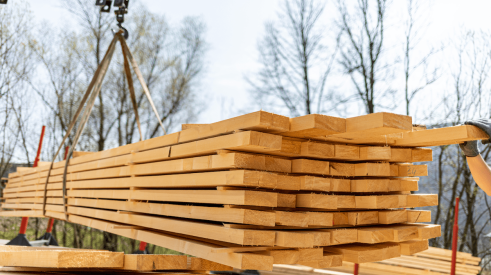|
|
Some builders view the electronic gadgetry associated with home automation systems as part of a distant, hi-tech future. But for many others, the future is now.
This third article on the PATH Concept Home focuses on modern home automation systems. With its "disentangled" utilities, the Concept Home provides fewer impediments than traditional homes to installing and upgrading a home automation system. That's because it separates the home's structure, the floor plan, and the various utilities into three distinct systems.
While a home automation system can be installed into just about any home, one that reflects the principles of the Concept Home can better accommodate a system that links the lights, thermostat, TVs, stereos and security system to a central control unit. Without organized utilities, homeowners can have unidentified wires running through every wall cavity, while any upgrades to the system will require them to tear those walls apart.
 |
|
With a home automation system, consumers can control their lights, thermostat, TV, stereo, and security system with a central control unit.
|
 |
|
Homeowners don't even need to be at home to manage their automation system, but simply connect through the Internet to adjust the thermostat or set the security system.
|
Keeping Up with Technology
In today's hi-tech world, some homeowners may place as much priority on being "wired" as they do on their plumbing.
"Ten years ago in our business, not even a thought was given to audio-visual and communications equipment, as far as where things would go or if there would be a need for expanded wiring," says Scott Sevon, president of Sevonnco, Inc., a custom home builder in Palatine, Illinois, near Chicago. "A builder would just put in an outlet for the TV and maybe a phone line."
But the rapid growth of the home automation market has changed all that. Home automation revenue is projected to hit $5.3 billion by 2007, up from $1.8 billion in 2002, according to the research firm In-Stat/MDR. The number of installed home systems in the United States and Canada could reach 28 million by 2007, more than three times the number in 2002.
As a result, Sevon says many builders now consider how a home can grow and adapt with technology. That means considering a place for wiring that distributes high-speed broadband, telephone, data and video.
While home automation systems can be installed using traditional copper wiring, the industry prefers structured wiring because of its greater capacity.
Structured wiring consists of four twisting pairs of high-capacity copper wires in an insulated sheath. This kind of wiring better accommodates home automation systems by easily transmitting broadband signals into and out of the home, as well as between devices within the home.
With that sort of capability, homeowners can coordinate HVAC (heating, ventilation, air conditioning), lighting, communications, entertainment and security systems from a single PC, which doesn't even have to be located in the home. "The growth of broadband connections like DSL and cable modem have made Internet access a popular feature of automation systems, because it allows you to check on your home from your office or laptop PC," says Jay McClellan, president of Home Automation, Inc. of New Orleans, Louisiana.
Savings and Security
The benefits of being "wired," however, are not limited to cool gadgets. Indeed, consumers often cite much more fundamental reasons: savings and security.
Home automation systems can save considerable amounts of energy. Direct savings come from automatic shutoff features and occupancy sensors, while indirect savings are possible through utility peak-load shifting programs.
Load shifting works by allowing homeowners to take advantage of off-peak rates offered by some utilities. With a home automation system, homeowners can program appliances to deactivate during peak demand hours.
A home automation system that provides zoned and programmable HVAC also generates energy savings. By regulating household temperatures through occupancy sensors, a system can provide more heat and air to areas of the home that are used frequently, while decreasing HVAC to zones used less often.
Another attractive feature of home automation is safety and security, says Tim Shriver, president and CEO of Home Automated Living in Laurel, Maryland. "With home auto-mation, security is limited by only our imaginations. For example, a few blocks away from my home, I can call up my security system and notify it that I am going to be home in 10 minutes. If I am not home in 10 minutes — if I am in an accident or someone robs me at the front door — it knows something is wrong and can notify authorities."
Safety benefits are even greater when the residents of the home are elderly or disabled. With the use of Web cams and motion sensors, relatives and guardians can know that their loved ones are safe. For residents with limited mobility, a home automation system can also make day-to-day living much more manageable.
"It's all about accessibility and the comfort of knowing you can set the alarm or the thermostat simply by picking up the phone," says Shriver. "Having to go downstairs can be a big issue for someone with disabilities."
Beyond Wires
Today, all of these great features require wires and cables running throughout the house. But someday, wireless - or radio frequency -communications will be the norm.
For consumers who simply want an automation system that integrates security and lighting components, that day has already arrived. "Installing a [wireless] system is no more difficult than putting in an alarm system," McClellan says.
Once wireless technology evolves to provide better Internet access, which could happen any day now, the wireless home is more likely to become a reality, Shriver says. Until then, a structured wiring foundation is the way to go, McClellan believes, particularly with home electronics increasingly connecting to the Internet.
To accommodate changing technology, the Concept Home offers not only accessible pathways in the walls, but also accessible electrical raceways along baseboards. Such raceways could be particularly beneficial for those seeking to upgrade their home automation systems down the road. Like wall chases, an electrical raceway would allow greater access to wiring in the home. So as technology improves, old systems can more easily be replaced with the "latest thing."
The Future Is Now
With recent electronic advances, home automation is increasingly part of builders' thought process, says Sevon, who has been building homes since 1983. According to the National Association of Home Builders, 34 percent of builders now offer structured wiring packages as standard or optional amenities.
"Reports from builders and contractors indicate that consumers have a clearer expectation of what home automation is," McClellan says. "For most, it is lighting control, temperature control, and security, which work together for comfort, convenience, energy savings and safety."
And that spells market readiness. If consumers understand it, builders would do well to understand it, too.
INTRODUCING A POWERFUL FABRIC
Whether they run through wall cavities or through the chases of the PATH Concept Home, the wires and cables needed to operate a home automation system can be a real mess. While wireless technology may someday replace communication cables, how do you transmit power to all of these devices without running wires to them?
The answer could be electro-textile fabric, according to PATH's Technology Scanning, which researches innovations in other fields and see how they might apply to housing.
Electro-textile fabric, which was originally developed by the U.S. Army for military uniforms, is woven with conductive materials, which offer alternative methods for data and power transmission.
When applied to housing, components and interconnections are intrinsic to this potential wallcovering, which makes them less visible and not susceptible to becoming tangled or snagged, according to the Virginia Tech E-textile Laboratory. Therefore, otherwise passive cloth becomes an integral part of a home's electronic and communications systems.
That means an electronic device could literally be connected anywhere, without being dependent on the location of traditional outlets and data ports. Furthermore, the homeowner could add electronic and communications without installing new wiring.
Now, that's flexibility.
Advertisement
Related Stories
Awards
6th Annual Most Valuable Product Awards
Drumroll ... Please join us in celebrating our 6th Annual MVP Awards winners, which represent the best in innovative building products
Sustainability
Fortera Takes Concrete Steps to Reduce the Climate Impact of Cement
Clean-tech company Fortera, which uses technology to capture carbon emissions form cement manufacturing, will open its first commercial-scale operation on April 12, 2024, in California
Building Materials
Lumber Leads Building Materials Prices Higher in March
Overall, the cost of building materials rose during March, with softwood lumber, gypsum products, and concrete all seeing price increases. Only steel mill materials saw price drops






